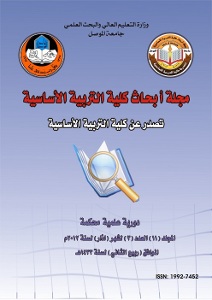The Impact of Using Cooperative Learning on the Achievement of Second Intermediate Pupils in English and the Development of their Interest in Language
Abstract
. . (70) . (30) (20) () (0.80) . . . The present research aims at investigating cooperative learning on the achievement of second intermediate pupils in English and the development of their interest in language. The population of the study consists of second grade female pupils at intermediate stage. The sample of the study was chosen randomly from among female intermediate school in the city of Mosul. It consisted of (70) pupils. The researchers chose the posttest equivalent group of experimental design. Therefore, the first group represented the experimental group (34 pupils) which was taught by using cooperative learning (STAD) strategy while the second group represents the control group which was taught by the conventional method. After achieving coequivalence between them, the researchers designed an achievement test which was a transformational items that consisted of (30) items divided into two parts. The researchers prepared the tool of interest in language that consisted of (20) items. Its consistency has been counted through the use of retest method via Pearson coefficient factor, it is (0.80). After applying the experiment, the tool was applied on both groups, Ttest showed the superiority of experimental group over the control group in CL achievement in English. The results indicated that the use of CL helped to increase the achievement of second intermediate pupils in English, in addition CL helped increasing the possibilities of cooperative among the pupils. The results also revealed the priority of the experimental group upon the controlling group in increasing the degree of interest towards the study of this subject. Thus, this was clear from post application of this tool and this indicates the activity of using this method.
